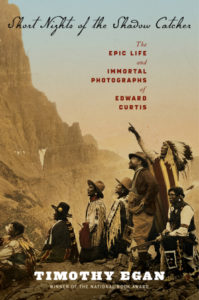Edward Sheriff Curtis, a grade-school drop-out, started his career in Seattle where he opened a photography studio. He was drawn to an old Indian woman who, by law, wasn’t even supposed to live in town, even though the city was named after her father, Chief See-ahlsh. Although often tormented by rock-throwing school boys and barely tolerated by Seattle citizens, Princes Angeline, the name given her because her real name was unpronounceable, refused to leave. Curtis finally talked her into letting him take her photograph at his Seattle studio. The photograph, taken in 1896, is remarkable in its detail.
Edward Curtis’s ambition was to produce a 20-volume publication of Native American communities in the early 20th Century. Even today, the logistics of such a project would be daunting, but considering the hardships involved—difficult travel, language barriers, bulky equipment—it was a remarkable achievement. In quest of his project, he enlisted the help of the day’s big thinkers, including President Theodore Roosevelt. Even so, he was constantly plagued by lack of funds. He received no personal pay for his life’s work; all monies went into the production of the publication.
Curtis spent three decades documenting the stories, rituals, and even some languages of more than eighty North American tribes. It took tremendous energy. The title of the book “Short Nights” hints to this–Curtis rarely slept. The “Shadow Catcher” was the name Native Americans gave to him.
The undertaking influenced Curtis profoundly. He became an outraged advocate of the American Indian’s plight: the broken treaties, missionaries “misguided missions,” the deplorable treatment of innocent women and children by the U.S. Army.
Short Nights of the Shadow Catcher: The Epic Life and Immortal Photographs of Edward Curtis features many of the Curtis photographs, and they are stunning. The limited 20-volume publications, The North American Indian, produced between 1907 and 1930 are highly valued today and are considered a “literary, artistic, historical masterpiece.” In appearance and texture, the books are among the most luxurious ever printed.
Author Timothy Egan, Pulitzer Prize-winning writer for the New York Times and best-selling author of seven books, has written a riveting biography. Short Nights of the Shadow Catcher is a well-told story of Edward Curtis, a remarkable man who has enriched our understanding of the Native American.



Good review, Mary. It is informative and brings to light the greatness of the photographer as well as the plight of the Indians.
Although I was aware of most of the plight of Native American,this book reiterated the grave injustices done. Thanks for your comment, Hema.
Great Review, Mary. He is a remarkable photographer! I really need to purchase this book.
Thank you, Carmen. I think it’s a good book for you to purchase, rather than check out at a library. The pictures are wonderful and you’ll want to have this book handy.
Excellent review, Mary. And timely. The tragedy in Orlando brought the media to say it was the worst “domestic killing” in our history but Wounded Knee and other killings of native men, women and children whether by direct assault of the military or providing small-pox laden blankets to a tribe were the first and worst. Curtis did his best to help us to remember. Egan has carried that forward which is good since as human beings, we have such short memories.
I agree, Jane. Although I knew a lot of the history, I was again shocked at the cruelty. What a man, Edward Curtis. I can’t even imagine putting a 20-volume collection together today. Imagine the hardships.
I enjoyed this review, Mary. Edward Curtis is one of my favorite photographers of Native Americans and I always relish tidbits of his life, like yours here. I remember the visit to Atelier 6000 studio in Bend, OR, last year during the WWW Conference where some noted Curtis photographs were exhibited. There was so much to see in such a short time!
Yes, that was a terrific segment of our conference. If I’d had time I would have liked to go back and take it in again.